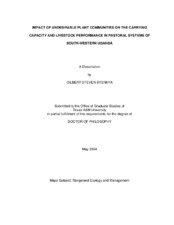| dc.contributor.advisor | Stuth, Jerry W. | |
| dc.creator | Byenkya, Gilbert Steven | |
| dc.date.accessioned | 2004-09-30T01:48:23Z | |
| dc.date.available | 2004-09-30T01:48:23Z | |
| dc.date.created | 2003-05 | |
| dc.date.issued | 2004-09-30 | |
| dc.identifier.uri | https://hdl.handle.net/1969.1/255 | |
| dc.description.abstract | The impact of undesirable plant communities (Cymbopogon afronardus and woody species dominated by Acacia species) on livestock carrying capacity and performance was investigated on 15 farms in an Acacia/Cymbopogon dominated pastoral system of south-western Uganda. Species prevalence based on basal cover for grasses, frequency for forbs and effective canopy cover for trees/shrubs were determined on farms. The PHYGROW model was used to predict forage productivity for computation of carrying capacity. The NIRS/NUTBAL nutritional management system was used to determine cattle dietary CP and DOM through fecal scans and to estimate animal performance.
Cymbopogon afronardus had a prevalence of 10.29% among the grasses while Acacia gerrardii (34.37%) and Acacia hockii (33.66%) were the most prevalent woody species. Forage productivity differed significantly among the farms with a mean long-term annual forage yield of 4560(SE+41) kg/ha. Farms infested with Cymbopogon and woody species produced the least amount of forage and therefore had the lowest carrying capacities (0.38 -0.39 AU/ha) while improved farms had comparatively higher forage yields with higher carrying capacities (0.49 - 0.52 AU/ha). A mean carrying capacity for the system was estimated at 0.44 AU/ha using a 25% harvest efficiency for ANPP. All the farms were overstocked, on average by 3.2 times.
Livestock BCS, diet CP and DOM were significantly different (P<0.0001) among the different farm types. BCS were highest on improved farms and lowest on Cymbopogon infested farms while dietary CP and DOM values were lowest on improved farms and highest on farms with a high woody component. Farms with a relatively high woody component exhibited intermediate BCS despite the high dietary CP values. Cattle on Cymbopogon infested farms had consistently lower body weights over the months although there were no significant differences in daily live weight gains among farms.
Recommendations included need for research into appropriate control measures for both Cymbopogon afronardus and woody species, farmer sensitization about overstocking, research to improve forage quality on improved farms and need for feed supplementation for improved breeds on improved farms. Integration of NIRS/NUTBAL and PHYGROW models into the research and management systems was desirable. The observed increase in Sporobolus spp. required investigation. | en |
| dc.format.extent | 1373107 bytes | en |
| dc.format.extent | 285600 bytes | en |
| dc.format.medium | electronic | en |
| dc.format.mimetype | application/pdf | |
| dc.format.mimetype | text/plain | |
| dc.language.iso | en_US | |
| dc.publisher | Texas A&M University | |
| dc.subject | Cymbopogon afronardus | en |
| dc.subject | woody species | en |
| dc.subject | carrying capacity | en |
| dc.subject | stocking rate | en |
| dc.subject | PHYGROW | en |
| dc.subject | NIRS | en |
| dc.subject | NUTBAL | en |
| dc.subject | livestock | en |
| dc.subject | Uganda | en |
| dc.title | Impact of undesirable plant communities on the carrying capacity and livestock performance in pastoral systems of south-western Uganda | en |
| dc.type | Book | en |
| dc.type | Thesis | en |
| thesis.degree.department | Rangeland Ecology and Management | en |
| thesis.degree.discipline | Rangeland Ecology and Management | en |
| thesis.degree.grantor | Texas A&M University | en |
| thesis.degree.name | Doctor of Philosophy | en |
| thesis.degree.level | Doctoral | en |
| dc.contributor.committeeMember | Smeins, Fred E. | |
| dc.contributor.committeeMember | Kreuter, Urs | |
| dc.contributor.committeeMember | Grant, William E. | |
| dc.type.genre | Electronic Dissertation | en |
| dc.type.material | text | en |
| dc.format.digitalOrigin | born digital | en |


